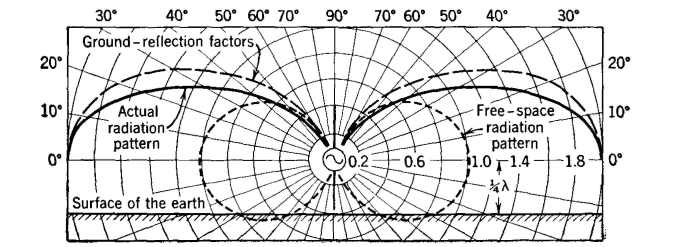| Electrical Communication is a free textbook on the basics of communication technology. See the editorial for more information.... |

|

Home  Radio Wave Propagation and Antennas Radio Wave Propagation and Antennas  Radiation Patterns from Periodic Straight-Wire Antennas Radiation Patterns from Periodic Straight-Wire Antennas |
|||||||||






|
|||||||||
Radiation Patterns from Periodic Straight-Wire AntennasIf the free-space radiation pattern (Fig. 13) of an antenna is modified by the application of ground-reflection
factors (Fig. 15), or by equation 13 or 14, the theoretical radiation pattern of an antenna near the earth is obtained. In the following discussion half-wave antennas will again be considered, and the radiation in the most important planes will be depicted. Horizontal Half-Wave Antennas, Vertical-Plane Radiation. The plane to be considered in this paragraph will be the vertical plane in which the antenna lies. As an example of the method of calculation, Fig. 16 has been included, which shows how the solutions are made for a half-wave antenna λ/4 above the earth. Thus, at 60°, the free-space radiation is 0.8, the reflection factor is about 2.0, and the theoretical
radiation at 60° is 0.8 x 2.0 = 1.6., as shown in Fig. 16. The radiation at other angles is found in the same way. This same method is used to determine the radiation patterns (Fig. 17) for half-wave antennas at heights other than λ/4. The radiation pattern to be considered in this paragraph is for a plane passing at right angles through the center of a horizontal half-wave straight-wire antenna. The pattern will have the same shape as the plot of the ground-reflection factors of Fig. 15 (a) for the antenna height under consideration (Fig. 17). This is because in free space the radiation as "viewed" from the end of a half-wave straight-wire antenna is a circle. Horizontal Half-Wave Antennas, Horizontal-Plane Radiation. Theoretically, this antenna radiates no energy in a horizontal plane in which the antenna lies, because the reflection factors at a vertical angle of 0° are zero, as Fig. 15 (a) indicates. But, at many vertical angles there is radiation, and a plot can be made37 of field intensities at these vertical angles in the various horizontal, or azimuth, directions from the antenna. Referring to Fig. 16, at 40° the radiation in the vertical plane in which the antenna lies is approximately 1.1 as determined from the "actual radiation pattern." At 40° at right angles to the
center of the antenna the radiation is approximately 1.7 as determined from the "ground reflection factors," which, as mentioned in the preceding paragraph, is also the radiation pattern in a plane passing through the center of the antenna at right angles. Vertical Half-Wave Antennas, Vertical-Plane Radiation. The plane to be considered is any vertical plane in which the antenna lies. As an example, Fig. 18 has been included, which shows how the calculations are made for a half-wave antenna the center of which is λ/4 above the earth. Thus at 30° the free-space radiation is about 0,8, the reflection factor is about 1.4, and the theoretical radiation at 30° is 0.8 x 1.4 = 1.12, as shown in Fig. 18. The radiation at other angles is found in the same manner. This same procedure is used to determine the radiation patterns for half-wave antennas at heights other than λ/4. Vertical Half-Wave Antennas, Horizontal-Plane Radiation. The radiation pattern in a horizontal plane for a vertical half-wave straight-wire antenna at any height above the earth will be a circle. This can be visualized by "looking down" on Fig. 18. The radiation in all horizontal directions is uniform. However, the radiation at a vertical angle of 0° (the surface of the earth) is greater than the radiation at some vertical angle. It should be mentioned that losses in the surface of the earth and in objects on the surface of the earth reduce the radiation along the earth below the values indicated by Fig. 19.
|
|||||||||
Home  Radio Wave Propagation and Antennas Radio Wave Propagation and Antennas  Radiation Patterns from Periodic Straight-Wire Antennas Radiation Patterns from Periodic Straight-Wire Antennas |
|||||||||
Last Update: 2011-05-18





